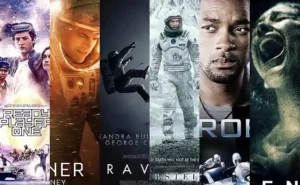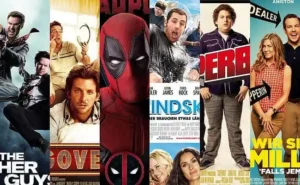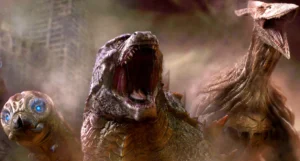Table of Contents
Before we get into our list of the 20 best sci-fi movies, we need to clarify what exactly falls under the term sci-fi or science fiction. The decisive characteristic of science fiction is by no means Alien Visitors or a plot set in the future, but a critical look at current developments and how they may affect the future.
A distinction is made between hard and soft science fiction. Hard science fiction focuses on technology and natural sciences and plays out scenarios of scientific progress. Soft science fiction, on the other hand, focuses on socio-scientific problems – the most important sub-genre of soft sci-fi is a dystopia, i.e., the opposite of utopia. If you draw this strict distinction to fantasy, one thing is already clear: space fairy tales like Star Wars or Guardians of the Galaxy have no place on this list if you take them very seriously.
If we had included them in the 20 best sci-fi films list, they would have made it into the top 5 because they are great films. But we want to limit ourselves to films that clearly belong to science fiction because even then, there are far more great works than fit into this list.
20. Arrival
Movies about alien visitation abound, but few are as realistically and intelligently made as Arrival.
The film is about linguist Dr. Louise Banks and physicist Ian Donnelly, who is tasked by the U.S. military with contacting aliens who have appeared on Earth in large, monolithic spaceships called “shells” because of their shape. In the alien ship, a glass wall separates the scientists from the visitors, who communicate with signs painted on the wall.
Banks and Donnelly successfully decipher the logographic signs and communicate with the aliens at regular meetings. But not all humans are eager for peaceful coexistence with the mysterious alien visitors. A global crisis is brewing.
While Arrival may seem like a quiet film about an alien invasion, it’s quite exciting. This is due to a plot in another time-plane that only ends at the end. It paints a convincing picture of what it would take to communicate with visitors from other planets.
19. Hitchhiker’s Guide to the Galaxy
The novel Hitchhiker’s Guide to the Galaxy by Douglas Adams, itself based on a radio play, has an absolute cult following, and many elements from it have long since been incorporated into everyday culture. For example, we know from the book that the meaning of life is 42 and that you should always have a towel with you.
In 2005, the cult book full of highly intelligent nonsense was finally adapted for the big screen. Both the book and the film are about Arthur Dent, a Briton who is taken on an adventurous hitchhiking trip across the Galaxy by his alien friend Ford Prefect on the day the Earth has to make way for a hyperspace bypass. The two boards, the Heart of Gold, were kidnapped by galactic president Zaphod Beeblebrox and his lover Trillian. Also in the game is the manic-depressive robot Marvin.
18. Contact
“If we’re the only ones in the universe, it’s quite a waste of space,” said the father of Dr. Eleanor “Ellie” Arroway when he watched the stars with her as a child. Spurred on by this, scientist searches for intelligent life on distant planets. Her colleagues largely ridicule the far-from-successful research, and in the end, Ellie’s funding is cut off.
The big industrialist S. R. Hadden then continues to fund the research. Ellie is then able to pick up a signal coming from star Vega. It consists of prime numbers, recordings from the 1936 Summer Olympics, the first radio signals strong enough to reach aliens, and blueprints for a machine that could allow travel to its senders.
Contact is an exciting as well as intelligent film about a possible contact by extraterrestrials. As with Arrival, the focus is on communication with the aliens and the effects on humans, thus holding up a mirror to the viewer.
17. Interstellar
By the end of the twentieth century, Earth had become almost uninhabitable, and all work was focused on extracting food. Mankind needs a new home. NASA, which now operates only in secret, discovered a wormhole years ago that leads to a planetary system orbiting a black hole. Scientists are sent to find a new home beyond the wormhole. For a second expedition sent after the first, a journey through space and time begins.
Christopher Nolan is undeniably one of the best directors of our time, and Interstellar is also an absolutely captivating film with an outstanding cast. The film skillfully plays with time passing differently due to different gravities while telling a moving story of hope and loss.
16. V for Vendetta
Alan Moore is widely regarded as the best comic book writer in history, and V for Vendetta is among his most acclaimed works. Unsurprisingly, there was a film adaptation of V’s story. This is a tale of the masked avenger V who plans to create a revolution in the totalitarian-run United Kingdom. He also takes aim at officials from the Northern Fire Party in which the country is held captive. V receives surprising support from the young journalist Evey Hammond.
V for Vendetta is a gripping film about the struggle of an anarchist against a fascist regime. The Guy Fawkes mask V gained notoriety far beyond film and comics through the Anonymous movement.
15. Alien
The Alien films offer a dark mixture of science fiction and horror since the first film. The series’ main antagonists are the Xenomorphs, insect-like alien life forms with acid for blood and an insatiable hunting instinct. People, above all Ellen Louise Ripley (protagonist of the first four of the six films), compete against them in life-and-death battles aboard spaceships, on alien planets, and, at one point, in prison.
Despite all the dark, dystopian horror, the film series also raises existential questions – especially in the prequel Prometheus – Dark Signs. In addition to the sinister atmosphere, the impressive animation technique that brings the xenomorphs to life is particularly noteworthy.
14. Ghost in the Shell
What makes a human being a human being? This existential question is at the center of all film adaptations of the manga Ghost in the Shell. The films are set in the future, where corporations rule the world, and most people have replaced body parts with cybernetic implants. Even brains are partially technically upgraded. The real human brain cells are called Ghosts, and the biocapsules that protect them are called shells. The films tell the story of a special unit that is supposed to catch a hacker who cracks the security barriers of the shells and thus can control the cyborgs.
As already mentioned, several film adaptations of the material are absolutely worth seeing, visually stunning thrillers with gripping story that raises existential questions.
13. Star Trek
In the 1960s, the Star Trek franchise imagined by Gene Roddenberry saw the light of day. Roddenberry’s sci-fi universe is now comprised of seven television series as well as thirteen feature films. Unlike the TV series, these feature films are about the Enterprise crew. They alternate between Kirk, Picard, and Kirk again.
To go into each film’s plot would go beyond this article’s scope, but considering the enormous popularity of the stories about Captain Kirk and Mr. Spock probably also not necessary.
12. Mary Shelley’s Frankenstein
Mary Shelley’s novel Frankenstein, or Modern Prometheus, is considered the founder of the entire science fiction genre and has been made into many films. Most adaptations, however, are very free interpretations of Shelley’s novel, which is brilliant in its analysis of human nature.
Of all the film adaptations of the material, Kenneth Branagh’s 1994 version, despite some big differences, is the closest to the original. This tells of medical student Victor Frankenstein, who creates an artificial, human-like creature while studying in Ingolstadt, Germany, and then discards it. When the creature realizes humans will never accept her, she turns against her creator.
As long as there is no true-to-life film version of Shelley’s cult novel, this film is still the best choice for all lazy readers.
11. Minority Report
Washington D.C., 2054: John Anderton works as a team leader for the Precrime Division, which uses three precogs, people with clairvoyant abilities who are kept in a twilight state with drugs, to predict murders and apprehend the perpetrators before they commit the act.
The names of perpetrators and victims are engraved on wooden balls. Furthermore, the course of events and the location of the events is determined with the help of the visions of the Precogs. One day Anderton’s own name is on a bullet as that of a culprit. He does not know the name of the alleged victim. For Anderton, a race against time and his own colleagues begins.
Minority Report is a thriller as tense as it is problematic, directed by no other than Steven Spielberg. The film raises questions about morality and guilt while telling a highly engaging, gripping story.
10. Clockwork Orange
Clockwork Orange, better known by its English title A Clockwork Orange, which actually means “a wind-up orange,” is a dystopian sci-fi thriller by master director Stanley Kubrick.
In the film, Alexander DeLarge tells his own life story. In it, he begins as the leader of a brutal youth gang who loves Beethoven; when he is betrayed by his companions, who no longer like Alex’s leadership style, he is arrested and sentenced to 14 years in prison for a murder committed.
In the first two years of imprisonment, Alex ingratiates himself with the prison pastor, which leads to his being proposed for a new conditioning therapy. In the process, his eyelids are held open with clamps, and he is forced to watch extremely brutal and disturbing images while a previously administered serum causes severe nausea. After 14 days of daily ordeal, Alex is released as cured.
Kubrick’s dystopia is one of the most oppressive works in film history. With its cruel protagonist and equally barbaric treatment methods, it also generates a certain amount of nausea in the viewer. In the process, the film raises tantalizing questions about culpability and sentencing.
9. The Hunger Games
Katniss Everdeen lives in District 12 of the country of Panem. Each year, the Capitol governs the twelve districts. They lose the war against it and are forced to send one boy or one girl each year to the Capitol. There, they will compete in an arena for the right to win. Katniss is one of the 24 young people who must fight in the so-called Hunger Games. Unfortunately for Katniss, her opponents in the arena include Peeta Mellark, a boy from her district to whom Katniss owes her life.
Suzanne Collins’ dark dystopia is a thrilling tale of love, betrayal, revolution, and man’s cruel lust for sensation. The film adaptation of the three novels in The Tribute to Panem trilogy includes four films (Part 3, Mockingjay, was split in two).
8. The Matrix (Trilogy)
In 1999, the Wachowski sisters, who were, in fact, brothers at the time, first took us into an artificial reality created by artificial intelligence, where the machines kept enslaved humanity conscious while exploiting their bodily energy. This virtual reality, which looks like Earth in 1999 to the people trapped inside, is called the Matrix.
The film trilogy tells the story of Thomas “Neo” Anderson, whose destiny is to end enslavement by machines and free humanity. The intelligent sci-fi thriller captivates with a multi-layered meta-level and impressive action sequences, for which the creators developed their very own shooting technique. This so-called bullet-time makes it possible to drive through a frozen image with the camera.
7. Watchmen
Alan Moore’s graphic novel Watchmen is the only comic critics unanimously agree on in great world literature. After many failed attempts and without Moore’s support, Zack Snyder finally succeeded in filming the work in 2009, 23 years after the comic was published. It tells the story of five masked vigilantes and a man with considerable supernatural abilities, Dr. Manhattan, during the Cold War.
After vigilantism is outlawed, one, Ozymandias, makes his true identity public and cleverly markets himself. Three others, Dr. Manhattan, Silk Spectre, and the Comedian, enter the service of the government; one, Nite Owl, retires, and another, Rorschach, continues despite the ban. Then the six are shaken by the murder of the Comedian, which Rorschach tries to solve. It shall turn out that Rorschach is on the trail of a large planned conspiracy.
The film and comics are highly critical works with multifaceted, complex characters. In the world of Watchmen, there are no good and evil, only different perspectives on the problems of a world on the brink. So the audience must decide which of the six heroes they will stand by.
6. Inception
In a world where immersion in the dreams of others has been made possible through what is known as dream sharing, Dominick Cobb specializes in extracting secret information from people in their dreams. This procedure, in which the attackers can help shape their victim’s dream, is called Extraction. However, after a failed extraction, the impressed victim, a wealthy businessman, commissions Cobb and his team to perform inception, which is the implantation of an idea into another’s mind.
Christopher Nolan’s blend of sci-fi thriller and heist movie captivates with a compelling story and stunning images that emerge when the power of dreaming is fully unleashed.
5. Blade Runner
Things get really dark with our number 5 slot. Ridley Scott’s dystopian story about the rebellion of the so-called replicants (human-like androids with a lifespan of four years) against their creators was not a great success at the time of its creation. Today, this intelligent dystopia is considered one of the genre’s classics.
After a group of highly evolved replicants led by Roy Batty hijack a spaceship and kill humans in order to escape to Earth on the ship, former Blade Runner Rick Deckard is assigned to solve the case. In the process, he falls in love with a replicant who, until Deckart informs her, is unaware that she is not human. Deckard is thus plunged into a deep crisis of meaning. Like Ghost in the Shell, the central theme of this gripping sci-fi thriller is the question of what makes a person human in the first place.
4. Jurassic Park
In 1993, Steven Spielberg and Michael Crichton unleashed the dinosaurs on us for the first time. In the cult classic, scientists of the billionaire Dr. John Hammond with blood from mosquitoes encased in amber dinosaurs to be seen in a large theme park on a tropical island.
After an incident in which a velociraptor kills one of its keepers, Hammond is required to have the park assessed by experts, including paleontologist Dr. Alan Grant. When one of the park employees turns off the electric fences to escape unseen with stolen dinosaur embryos, the prehistoric animals break out and attack the visitors.
Jurassic Park not only impresses with great visual effects after more than 25 years but also reminds science to consider whether something is possible and whether it is wise to do so.
3. 1984
In his novel 1984 (a mistake in numbers, since the book was written in 1948), George Orwell, although a socialist himself, paints a depressing picture of the impending dangers of a socialist or rather Stalinist surveillance state. The film adaptation of the dystopian novel, which ironically actually appeared in 1984, is probably one of the most important science fiction films ever in an era of Prism and NSA.
Both the novel and the film show the dangers of an overpowering state that controls everything in the lives of its citizens. The story is told by Winston Smith, who retroactively adjusts newspaper articles in the Ministry of Truth to the party’s specifications, including adjustments in content and language. Big Brother, around whom a cult of personality is practiced, is omnipresent in the form of constant surveillance. Then Winston falls in love and meets his beloved, making him guilty of a so-called thought crime and being targeted by the Party.
2. 2001: A Space Odyssey
The year 2001 didn’t turn out at all as Stanley Kubrick imagined and pictorially captured on the screen in 1968, but the film of the same name is and remains one of the sci-fi classics par excellence, and it was a really close call between 2001: A Space Odyssey and our number 1 spot.
In impressive images, the film tells of an extraterrestrial monolith that influenced the evolution of mankind. After its rediscovery on the moon, a research spaceship is sent to Jupiter, to which the monolith has sent an electromagnetic signal. On board, in addition to the human crew, is the artificial intelligence HAL 9000.
The onboard computer is the only one who knows the mission’s true purpose. After this AI, considered infallible, makes a mistake, the astronauts consider shutting down HAL 9000. But he does not put up with that at all. A fight to the death breaks out between the crew and the onboard computer, and in the end, an incredible experience awaits the last survivor.
The film is most famous for its realistic depiction of space travel, its wide scope for interpretation, and its visually stunning settings accompanied by classical music.
1. Planet of the Apes (1968)
Four astronauts travel through space at almost the speed of light to test the hypothesis of time dilation. The only female crew member is dead when they awaken from their deep artificial sleep. The remaining three must fight their way through the inhospitable world of an alien planet until they encounter a group of humans. However, they cannot speak and behave more like animals.
The surprise is all the greater when a drive hunt against humans begins, for the hunters are apes in armor on horseback. One of the astronauts falls captive by the apes, who examine him. The talking man becomes a zoological precedent for the ape scientists, between whom two fronts soon emerge.
Planet of the Apes is based on the novel of the same name by Pierre Boulle and is probably the only film adaptation that is better than the book it is based on. This is in no small part due to the surprising ending, which puts everything in a different light in this biting satire on human society. The original Planet of the Apes is a sci-fi masterpiece whose twisty storyline later sequels and remakes couldn’t match, as only the 1968 film offers an ending that can reverse the roles of protagonist and antagonist within a single scene.
Of course, this list is just a small sample of the plethora of great science fiction films out there. For example, the Back to the Future movies, Stargate, District 9, Independence Day, Soylent Green, Brazil, Close Encounters of the Third Kind, War of the Worlds, Ex Machina, Children of Men, and 12 Monkeys narrowly failed to make a list.







